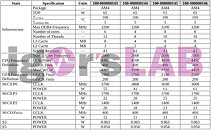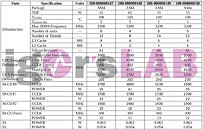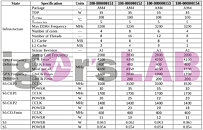Wednesday, May 13th 2020

OPNs for At Least Twelve Desktop AMD "Renoir" APUs Decoded
Igor's Lab discovered that AMD may be working on as many as twelve desktop Ryzen G "Renoir" processors with integrated graphics. These include six SKUs each covering the 65 W and 35 W TDP categories, and include two each of 8-core/16-thread, 6-core/12-thread, and 4-core/8-thread SKUs per TDP category. All twelve chips feature increased power limits from their mobile siblings, and a reference memory frequency of DDR4-3200. The parts also feature iGPU maximum engine clock boost frequency as high as 2.10 GHz, to overcome the compute unit deficit "Renoir" has against its predecessor, "Picasso/Raven Ridge," with their up to 11 CUs.
The series appears to be led by an 8-core/16-thread SKU with CPU boost frequency as high as 4.45 GHz, iGPU engine clock as high as 2.10 GHz, and various power-state clock speeds detailed in the table below. The 6-core/12-thread part boosts up to 4.30 GHz, with iGPU engine clock up to 1.90 GHz. The 4-core/8-thread part boosts up to 4.10 GHz, with up to 1.70 GHz iGPU engine clocks. The 35 W TDP parts have, on average, 200-300 MHz lower max CPU core boost- and nominal clock speeds, but more aggressive power-management as defined in the various P-states. Half of these OPNs point to chips with identical clock speeds and core configurations. These are probably differentiated from each other with some of them being Ryzen PRO SKUs.It stands to reason that all SKUs will be launched under the upcoming Ryzen 4000G-series branding. We already know that the 8-core parts will get a Ryzen 7 brand extension from the Ryzen 7 4700G leak. It's possible that the Ryzen 5 parts will be 6-core/12-thread, and Ryzen 3 4-core/8-thread. For the Ryzen 5 desktop APU series in particular, this would amount to a 50% increase in core- and thread-counts (from the 3400G), while it would see the introduction of SMT for Ryzen 3 desktop APU series (from the 3200G). Find some technical commentary in the Igor's Lab report at the source link below.
Source:
Igor's Lab
The series appears to be led by an 8-core/16-thread SKU with CPU boost frequency as high as 4.45 GHz, iGPU engine clock as high as 2.10 GHz, and various power-state clock speeds detailed in the table below. The 6-core/12-thread part boosts up to 4.30 GHz, with iGPU engine clock up to 1.90 GHz. The 4-core/8-thread part boosts up to 4.10 GHz, with up to 1.70 GHz iGPU engine clocks. The 35 W TDP parts have, on average, 200-300 MHz lower max CPU core boost- and nominal clock speeds, but more aggressive power-management as defined in the various P-states. Half of these OPNs point to chips with identical clock speeds and core configurations. These are probably differentiated from each other with some of them being Ryzen PRO SKUs.It stands to reason that all SKUs will be launched under the upcoming Ryzen 4000G-series branding. We already know that the 8-core parts will get a Ryzen 7 brand extension from the Ryzen 7 4700G leak. It's possible that the Ryzen 5 parts will be 6-core/12-thread, and Ryzen 3 4-core/8-thread. For the Ryzen 5 desktop APU series in particular, this would amount to a 50% increase in core- and thread-counts (from the 3400G), while it would see the introduction of SMT for Ryzen 3 desktop APU series (from the 3200G). Find some technical commentary in the Igor's Lab report at the source link below.



32 Comments on OPNs for At Least Twelve Desktop AMD "Renoir" APUs Decoded
I looked at yuzu and am not surprised. Nvidia and their extensions. And I don't mean in a cynical manner. It has been present since an undercover developer anonymously stated the state of the industry by naming them Vendor A and B.
I still hold the notion, treating mobile gpus as big gpus is besides the point. We are trying to make the most of active registers, nothing more. Having to schedule 2 cycles worth of data is great for instruction latency which frees up cycles. The gpu suddenly has twice the register fidelity in instruction sequencing. Using all registers for a single workload versus 5 different workloads with only a quarter of the registers active, you get the picture.
This is not the point in a 512 shader machine, but in a 4096 shader big die, you bet you could do better than the same automatic compiler just interleaving work and not looking out to shader runtime. You cannot expect memory to be the slowest proponent indefinitely. If it goes fast, you need a proper driver in the seat.
I love that the Switch can decode ASTC textures on the fly with no performance loss, and a desktop PC with an RTX Titan takes 17 seconds to finish the same task.
'A gpu is not an SoC' - that is what I'm getting from this. It warrants an explanation, imo.
What I mean is, software kills hardware. Sony did their own driver for the PS4, to avoid using the AMD ones, and rumour says that the Wii U used somthing closer to mesa than to the AMD driver. The GPU can only be as good as the software behind it.
AMD Ryzen 7 4700G 8/16 3.6 GHz 4.45 GHz DDR4-3200 Vega 8 CUs 2100 MHz 65W
AMD Ryzen 5 4400G 6/12 Vega 7 CUs 1900 MHz 65W
AMD Ryzen 3 4200G 4/8 3.8 GHz 4.10 GHz Vega 6 CUs 1700 MHz 65W
wccftech.com/amd-ryzen-4000-renoir-desktop-apu-specs-models-ryzen-7-4700g-leak-out/